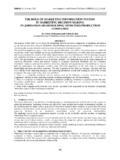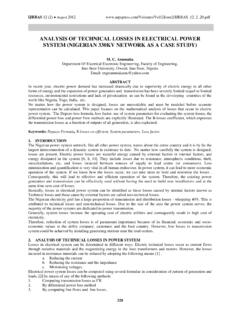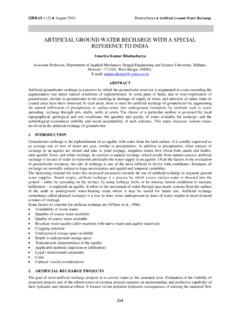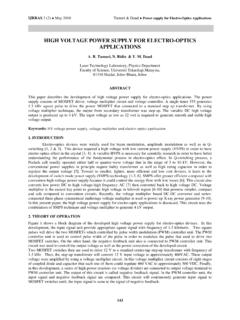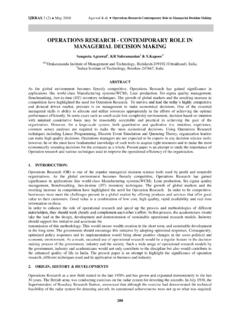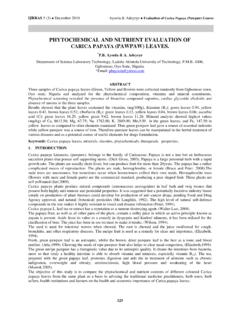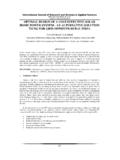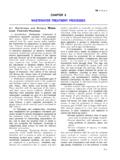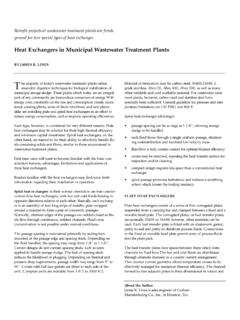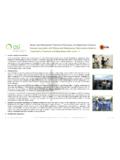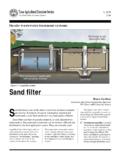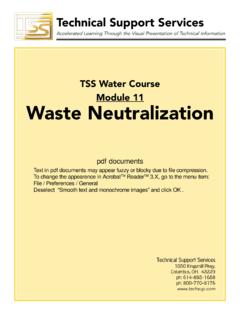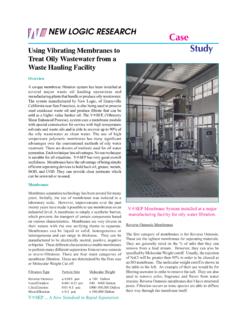Transcription of COAGULATION TREATMENT OF WASTEWATER IN …
1 IJRRAS 13 (1) TREATMENT OF WASTEWATER IN PETROLEUM INDUSTRY USING POLY ALUMINUM CHLORIDE AND FERRIC CHLORIDEH amidreza Farajnezhad1& Parvin student, Department of chemistry, Ahar Branch, Islamic Azad University, Ahar, Iran2 Department of Chemistry, Ahar Branch , Islamic Azad University, Ahar, IranABSTRACTR emoval of pollutants produced by industrial plants is requirement for reuse of water and obtains to environmental standards. Chemical COAGULATION process is an important and convectional method for WASTEWATER TREATMENT to reduce color, COD and TSS.
2 Choice of a suitable coagulant for maximum contaminant removal and reduction incosts is the most important parameters of WASTEWATER TREATMENT . In this study the feasibility of using poly aluminumchloride instead of ferric chloride in petrochemical WASTEWATER TREATMENT has been investigated. Based on the results of jar test the poly aluminum chloride is more efficiency and the flocculated formed by poly aluminum chloride is larger than flocculated formed by ferric chloride and so separation is desirable. Results show that varying of pH has no significant effect on color removal of petroleum WASTEWATER , so pH= was chosen as suitable :Poly aluminum chloride, Ferric chloride, COD, Color, INTRODUCTIONIn Iran, the petroleum industry is one of the most important industries of the country.
3 However, large volumes of WASTEWATER are generated during the process. Different conventional physicochemical and biological treatments have been used to treat the petroleum WASTEWATER . The pollutants in the petroleum WASTEWATER are different salts, surfactants, heavy metals, mineral oils and others. This WASTEWATER can cause serious environmental problems due to their high color, large amount of suspended solids, and high chemical oxygen demand. So, they have to be removed before being discharged into the environment. Because of the nature of the colloidal suspension, these particles will not sediment or be separated with conventional physical methods (such as filtration or settling) unless they are agglomerated through COAGULATION and flocculation.
4 Colloid particles are removed from water via COAGULATION and flocculation processes [1]. COAGULATION indicates the process which colloidal particles and very fine solid suspensions are destabilized, so that they can begin to agglomerate if the conditions are appropriate. Flocculation refers to the process by which destabilized particles actually conglomerate into larger aggregates so that they can be separated from the colloids commonly found in WASTEWATER are stable because of the electrical charge that they carry.
5 The charge of colloids can be positive or negative. However, most colloidal particles in WASTEWATER have a negative charge [2]. In addition, COAGULATION can also produce the removal of particles larger that colloidal particles due to the entrapment of such particles in the flocs formed during COAGULATION . In most water TREATMENT plants, the minimal coagulant concentration and the residual turbidity of the water are determined by the Jar-Test technique. Besides, physical-chemical TREATMENT allows reducing dissolved, suspended, colloidal and non settable matter as well as coloring from dyes.
6 COAGULATION or flocculation process was conducted for the TREATMENT of industrial WASTEWATER to achieve maximum removal of COD, TP and TSS[3]. Aluminum sulfate (alum), ferrous sulfate, ferric chloride and ferric chloro-sulfate were commonly used as coagulants [4].Therefore, Amudaa and Amoob [5] investigated the effect of coagulant dose, polyelectrolyte dose, pH of solution and addition of polyelectrolyte as coagulant aid and found to be important parameters for effective TREATMENT of beverage industrial WASTEWATER .
7 Besides, Guibal and Roussy [6], pointed that the COAGULATION and the flocculation of suspended particles and colloids result from different mechanisms including electrostatic attraction, sorption (related to protonated amine groups) and bridging (related to polymer high molecular weight). Adsorption [7], chemical COAGULATION [8], microfiltration [9], and photocatalytic processes [10] have been examined for TREATMENT of organics and petroleum constituents in oily wastewaters. Electrocoagulation also may be considered as an alternative TREATMENT method of oily wastewaters, as it has been applied successfully to oil and greasy wastewaters [11-12].
8 The aim of the present study is to evaluate and compare the effectiveness of ferric chloride and poly aluminum chloride (PAC) as coagulant in pre- TREATMENT of the petroleum WASTEWATER in different experimental conditions. The IJRRAS 13 (1) October2012 Farajnezhad & Gharbani WASTEWATER in Petroleum Industry307optimum pH and dosage needed to achieve the best performance of ferric chloride and poly aluminum chloride in COAGULATION process were EXPERIMENTAL Sample Collection and Materials Sample of petroleum WASTEWATER was collected from a petroleum company, which is situated in Tabriz, chloride ( ) and poly aluminum chloride , PAC ( Aln(OH)mCl(3n-m) were purchased from ChlorPars Company.)
9 Coagulant preparation Stock solutions of ferric chloride and poly aluminum chloride should be prepared before starting the solutions were prepared by dissolving 10g of each substance in distilled water and the solution volumes were increased to 1 liter. Each 1 ml of these stock solutions was equivalent to 20 mg/L when added to 500 mL of WASTEWATER . They have been prepared in three different concentrations, 10, 20 and 30 mg/L into distillated Jar test A conventional jar test apparatus was used in the experiments to coagulate sample of petroleum WASTEWATER by using ferric chloride and poly aluminum chloride.
10 It was carried out as a batch test, accommodating a series of six beakers together with six-spindle steel paddles. The pH of solution was controlled by adding H2SO4or NaOH. Before fractionated into the beakers containing 500mL of suspension, the samples of petroleum WASTEWATER were mixed homogeneously. Then, the samples were analyzed to measure color, pH, and COD for representing an initial concentration. Chemical characteristics of the raw WASTEWATER are given in Table the desired amount of poly aluminum chloride and ferric chloride was added to the suspension, the beakers were agitated at various mixing time and speed, which consist of rapid mixing (150 rpm) for 1 minutes and slow mixing (30 rpm) for 10 minutes to COAGULATION .

